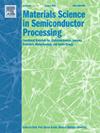基于氧化镁/锰硅异质结的高响应 MSM 紫外光检测器
IF 4.2
3区 工程技术
Q2 ENGINEERING, ELECTRICAL & ELECTRONIC
引用次数: 0
摘要
紫外线(UV)光电探测器(PD)因其广泛的应用而备受青睐。本研究采用溶胶-凝胶法和连续离子层吸附与反应法(SILAR)在石英玻璃上制备了 MgZnO/MnS 复合薄膜,用于紫外光检测。与 MgZnO 器件相比,MgZnO/MnS 器件克服了原有 MgZnO 光敏层载流子迁移率较低、陷阱较多的缺点,具有超高的响应率和检测率(4564.5 A/W,1.7 × 1016 Jones)、高光电流(高达 1.8 × 10-3 A)、较低的暗电流(低至 8.8 × 10- 10 A)和较高的明暗比(高达约 8 × 105),这归功于 MgZnO 和 MnS 之间的接触形成了 p-n 结,从而建立了内部电场作为耗尽层。内置电场消耗了大部分载流子,因此器件的电导率较低,而 MnS 填补了 MgZnO 表面的部分缺陷,从而产生了较低的暗电流。在紫外线辐射下,光生载流子被内置电场分离,导致电子-空穴对重组减少。这使得该器件显示出高导电性并产生高光电流。这些结果使得 MgZnO/MnS 光致发光器件有望应用于要求高响应率的设备中。本文章由计算机程序翻译,如有差异,请以英文原文为准。
High response MSM UV photodetectors based on MgZnO/MnS heterojunction
Ultraviolet (UV) photodetectors (PDs) are favored for their wide range of applications. In this work, MgZnO/MnS composite films were prepared on quartz glass by sol-gel and successive ionic layer adsorption and reaction (SILAR) methods for UV photodetection. Compared with MgZnO device, the MgZnO/MnS device overcomes the drawbacks of lower carrier mobility and more traps in the original MgZnO photosensitive layer, and has ultrahigh responsivity and detectivity (4564.5 A/W, 1.7 × 1016 Jones), high photocurrent (up to 1.8 × 10−3 A), lower dark current (down to 8.8 × 10- 10 A) and high light-dark ratio (up to about 8 × 105), which is attributed to the formation of a p-n junction by the contact between MgZnO and MnS, resulting in the establishment of an internal electric field to serve as a depletion layer. The built-in electric field consumes most of the carriers so that the device exhibits a low conductivity, and MnS fills up some of the defects on the surface of the MgZnO, which results in a low dark current. Under UV radiation, photogenerated carriers are separated by built-in electric field, leading the recombination of electron-hole pairs decrease. This causes the device show high conductivity and generate high photocurrent. These results make MgZnO/MnS PDs promising for applications in device requiring high responsivity.
求助全文
通过发布文献求助,成功后即可免费获取论文全文。
去求助
来源期刊

Materials Science in Semiconductor Processing
工程技术-材料科学:综合
CiteScore
8.00
自引率
4.90%
发文量
780
审稿时长
42 days
期刊介绍:
Materials Science in Semiconductor Processing provides a unique forum for the discussion of novel processing, applications and theoretical studies of functional materials and devices for (opto)electronics, sensors, detectors, biotechnology and green energy.
Each issue will aim to provide a snapshot of current insights, new achievements, breakthroughs and future trends in such diverse fields as microelectronics, energy conversion and storage, communications, biotechnology, (photo)catalysis, nano- and thin-film technology, hybrid and composite materials, chemical processing, vapor-phase deposition, device fabrication, and modelling, which are the backbone of advanced semiconductor processing and applications.
Coverage will include: advanced lithography for submicron devices; etching and related topics; ion implantation; damage evolution and related issues; plasma and thermal CVD; rapid thermal processing; advanced metallization and interconnect schemes; thin dielectric layers, oxidation; sol-gel processing; chemical bath and (electro)chemical deposition; compound semiconductor processing; new non-oxide materials and their applications; (macro)molecular and hybrid materials; molecular dynamics, ab-initio methods, Monte Carlo, etc.; new materials and processes for discrete and integrated circuits; magnetic materials and spintronics; heterostructures and quantum devices; engineering of the electrical and optical properties of semiconductors; crystal growth mechanisms; reliability, defect density, intrinsic impurities and defects.
 求助内容:
求助内容: 应助结果提醒方式:
应助结果提醒方式:


